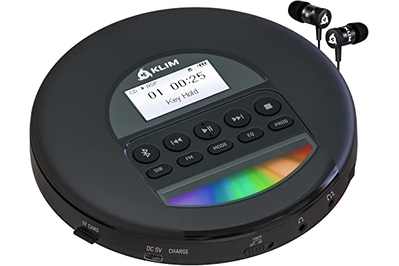The 3 Best CD Players of 2025

Budget pick
With its slim, disc-shaped, plastic enclosure, the Klim Nomad looks like the portable players that some folks remember from the 1990s. But it incorporates many modern touches, including a Bluetooth transmitter and a rechargeable battery. You also get an FM radio and MP3 playback from CD-Rs or TF (microSD) cards. The Nomad’s measured performance in our tests was unimpressive, but for portable and casual home use, it sounds fine.
This affordable player is packed with features. Besides all the extras noted above, the Nomad includes two headphone jacks, which will come in handy if you want to share your music with a friend.
Klim even threw in a semi-hardshell carrying case and a free set of earbuds. We expected the earbuds to be comparable to the junky freebies you get on airliners, but they’re much better. We found that the sound was a little trebly but still quite listenable. The earbuds have metal enclosures with magnetized backs that stick the left and right earbuds together to help prevent tangles, and the package includes foam and silicone tips.
The player also has an EQ button that lets you choose between five sound modes, including rock, classical, and jazz. We didn’t find them useful, but some people might like them, and they may come in handy if you’re stuck using lousy headphones.
The Nomad is highly portable. The round chassis has a 5.5-inch diameter and measures just 1 inch thick, so it’ll slip easily into a laptop bag. Unlike our other picks, it has a switch that locks the controls so that you don’t accidentally stop playback or skip tracks when handling the player or slipping it into your bag. The lid latches to protect the mechanism in transit.
Like our other picks, the Nomad reads the digital data from a CD into a buffer to prevent skipping. But the Nomad must have a really big buffer: In our tests, on occasion the disc would stop spinning and then restart only when the player needed more data. The music never stopped, though.
The large, backlit buttons on top make operating the Nomad easy even in dark settings. The battery ran for about 7 hours in our tests.
The FM radio and TF card reader are actually useful. Often, when such features are tacked on to inexpensive models, they’re so limited in functionality that they’re not worth fooling with. But on the Nomad’s top display, navigating MP3s stored on a memory card is easy.
The FM radio, which uses the headphones as an antenna, can automatically scan to find local radio stations, and the track-skip buttons let you choose among the stations. You can also tune stations manually using the display’s frequency readout, although it’s in 0.1 MHz steps, and it starts from 76 MHz (the lowest US frequency is 87.5 MHz), so getting to my favorite station, KSER 90.7 FM, took 147 button pushes.
Flaws but not dealbreakers
The technical performance isn’t impressive. Relative to our other picks, the Nomad’s frequency response drops by about 6 decibels in the deep bass (20 hertz) and 9 decibels in the high treble (20 kilohertz). I didn’t notice this difference in my listening tests because most music doesn’t contain much energy at those frequency extremes. But if you like dance or hip-hop music with an abundance of deep bass or classical music with lots of violins, flutes, and cymbals, you might hear it — although most headphones and earbuds don’t have impressive performance in those ranges, either.
The headphone output delivered only 8.1 mW of power into 32 ohms. That’s loud enough to get mass-market headphones and earbuds playing pretty loud, and it’s just 1.2 decibels less than what the Syitren R300 achieved.
It might not survive a few rough knocks. The Nomad’s enclosure is made from lightweight plastic, so it may not last through as many commutes as our other picks would.







